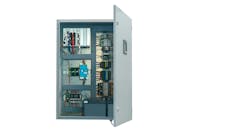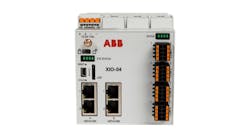IO-Link enables multi-functional sensors to be configured for a variety of operations
Aug. 6, 2024
Shishir Rege is product marketing manager—networking at Balluff.
What are the advantages of IO-Link in terms of diagnostics?
Shishir Rege, product marketing manager—networking, Balluff: IO-Link is a data communication instead of a signal communication, so the devices, such as measurement sensors, are not limited to providing 4-20 mA or 0-10 V signal for the measurement units. Instead, the actual engineering units can be transferred directly from the sensors. Having data communication onboard, sensors and other IO-Link devices also can communicate more information about the health of the sensor/device, as well as information about the ambience that the sensor resides in. IO-Link unleashes the sensor’s potential to not be limited to the process, but instead could help overall effectiveness of the automation and applications on the factory floor. The added diagnostics help monitor the condition of the environment or common faults that typically occur with the sensor. These added diagnostics help reduce the downtime on the line or the plant floors.
How does IO-Link handle multi-sensor devices? Can I configure and access data from individual sensors within a single IO-Link device?
Shishir Rege, product marketing manager—networking, Balluff: IO-Link made it possible to have multi-functional sensors that can be configured for a variety of operations. For example, an IO-Link smart photoelectric sensor can be configured for background suppression, diffuse or retro-reflective mode of operation ensuring various types of materials can be detected with the single sensor instead of having to implement multiple sensors. The same photoeye, depending on the manufacturer, could also offer condition monitoring features such as monitoring of vibration, temperature or humidity, as well. As the IO-Link device provides data communication, it allows for configuring several different parameters of the smart sensors.
What cable topology options are available with IO-Link? Can I use daisy-chain connections, or is a dedicated point-to-point connection required for each device?
Shishir Rege, product marketing manager—networking, Balluff: IO-Link is a point-to-point communication. Daisy chaining is not possible with IO-Link. Each IO-Link device connects directly to an individual master/gateway port. Balluff offers devices that have expansion ports to offer modularity of the device space, but it is not to be confused with daisy chaining.
How does IO-Link integrate with different fieldbus protocols commonly used in automation systems?
Shishir Rege, product marketing manager—networking, Balluff: IO-Link is a device level technology and not a control level technology. The fieldbus protocols such as EtherCAT, EtherNet\IP and Profinet are control level communication technologies. The IO-Link gateway module acts as an aggregator to collect the data from IO-Link devices and transfers that data over the fieldbus protocols to programmable logic controller (PLC) or controller at the control level.
What are the cost implications of implementing IO-Link compared to traditional wiring methods? Is the upfront cost of IO-Link devices offset by long-term benefits like reduced wiring complexity and improved diagnostics?
Shishir Rege, product marketing manager—networking, Balluff: IO-Link has been in the field for more than 14 years and has gained popularity because of the cable standardization and reduced wiring. Additionally, IO-Link providing data communication on the same cable that was used for discrete I/O also enables today’s automation to be smart and more effective. Traditional wiring requires much manual labor and has high propensity for mistakes and maintenance. The long-term cost is much higher while the machine build cost is also much higher with traditional wiring.
Most IO-Link implementations use M12 connectors and either single-ended or double-ended cables that significantly reduce wiring errors. Added diagnostics with IO-Link also help tremendously with incorrect wiring and for troubleshooting problems in the field.
Due to the popularity and adoption of IO-Link, there are hardly any add-on costs when switching from traditional wiring methods to IO-Link. In fact, most installations noticed considerable cost savings with IO-Link.
Anything else that you'd like to add about IO-Link?
Shishir Rege, product marketing manager—networking, Balluff: IO-Link as a technology is evolving at a rapid pace. IO-Link wireless technology offers standardization of wireless communication and enhances functionality of already familiar IO-Link technology. The recent addition of IO-Link wireless and upcoming products on IO-Link Safety are changing the way automation is done today. IO-Link not only adds benefits for machine builders in terms of faster machine builds, but adds value throughout the life-cycles of the machine well into the maintenance mode.






